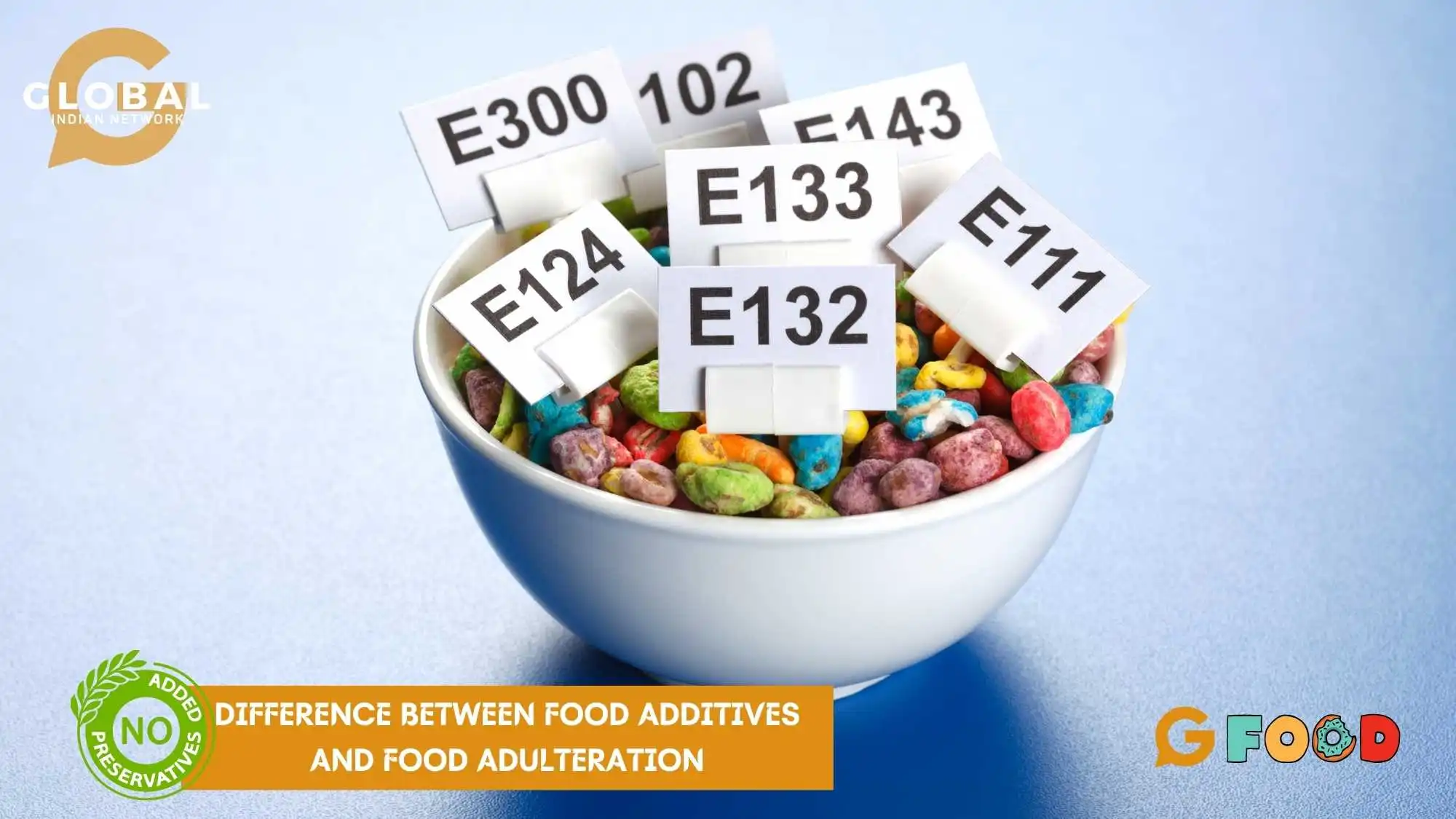Knowing the difference between food additives and food adulteration is important for anyone who cares about what they put on their plate. Although both phrases may sound like something close to the other, they are entirely different practices in the food industry. Food preservatives or additives are items that are deliberately added to food during production to improve flavour, food colouring, or shelf-life. In contrast, adulteration of food is the intentional addition of food contaminants or dilution of food substances with lower-quality, dangerous, or banned substances.
In this article, we'll examine the subtleties of these definitions, discussing their origins, functions, and human health issues and safety in order to develop a better understanding of food processing so as to make informed decisions about what you eat.
Table of Contents
What are Food Additives?
Substances added to food products to perform specific functions, such as preserving freshness, enhancing flavour, or improving appearance, have been utilised for centuries. The range and complexity of additives in food used by food manufacturers have expanded significantly. These substances can be derived from natural raw materials, like plants and animals, or created synthetically in laboratories.
There are several categories of these enhancements, each serving a unique purpose. Preservatives help extend the shelf life and preserve the quality of food by preventing spoilage caused by bacteria, mould, and yeast. Common preservatives include sodium benzoate and potassium sorbate. Antioxidants, like ascorbic acid (vitamin C), prevent the oxidation of fats and oils, which can lead to rancidity and off-flavours. They are an essential part of ensuring food safety.
Flavour enhancers improve the taste of food without contributing significant flavour themselves. Monosodium glutamate (MSG) is a well-known flavour enhancer used in savoury dishes. Food coloring is added through artificial food dyes and other colouring agents to restore or enhance the natural colour of food, making it more visually appealing. Examples include beta-carotene (which provides an orange hue) and caramel colour.
Emulsifiers and stabilisers help maintain the texture and consistency of food products. Lecithin, commonly found in chocolate and baked goods, acts as an emulsifier, keeping fatty acids and water from separating. Thickeners, like guar gum and xanthan gum, are used to achieve the desired viscosity in sauces, soups, and dressings.
While these substances offer many benefits, their use is regulated to ensure safety. In the UK, the Food Standards Agency (FSA) oversees the approval and monitoring of these substances, ensuring that they are safe for consumption and clearly labelled. This regulatory framework helps maintain good-quality products, bolsters trust, and reduces health risks in the food supply chain.

What is Food Adulteration?
Food adulteration refers to the deliberate act of degrading the quality of food by adding or removing certain substances. This unethical practice is often driven by profit motives, as it allows producers and vendors to reduce costs by using cheaper, inferior, or even harmful ingredients. It can also involve tampering with food to enhance its appearance, mask spoilage, or increase weight, all of which deceive the consumer.
Common methods of food adulteration include mixing impure or hazardous substances into food items. For instance, water is often added to milk to increase volume, while flour, brick powder or chalk powder may be used to adulterate spices and condiments. Fruits and vegetables may be coated with chemicals like calcium carbide to accelerate the artificial ripening of fruits, which can pose significant health hazards. Similarly, low-quality oils or fats are sometimes substituted for higher-grade counterparts, and food grains might be mixed with sand, husk, or other inedible materials.
Food adulteration can take various forms, depending on the method and intent behind it. Common types of food adulteration include intentional adulteration, where harmful or substandard substances to human health, like dyes, chemicals, or other contaminants, are deliberately added to food. Another type of food adulteration is incidental adulteration, which occurs when food is contaminated unintentionally, often due to poor hygiene or unsafe storage practices. Another type is metallic adulteration, where toxic metals such as lead or arsenic enter food products through utensils, processing equipment, or contaminated water. Each of the types of food adulteration poses unique challenges and risks to both consumers and the food industry, making strict vigilance and regulation essential.
The impacts of food adulteration are wide-ranging and deeply concerning. From a health perspective, consuming adulterated food can lead to immediate effects like food poisoning, digestive disorders, and allergic reactions. Long-term exposure to certain toxic adulterants and cheaper ingredients, such as lead or formalin, can result in chronic illnesses, including organ damage and even cancer. Beyond the physical harm, adulteration of food erodes trust in the food industry, undermining both public confidence and the reputation of legitimate manufacturers.
To combat this issue and promote the detection of food adulteration, governments and regulatory authorities enforce strict measures to ensure food safety. Bodies like the Food Safety and Standards Authority of India (FSSAI) monitor and penalise those engaging in adulteration in food during production for economic gain. Educating consumers as it pertains to their daily intake of food is also essential, as it empowers them to recognise and report suspicions of adulteration of food.
Simple practices, such as buying from reliable sources and verifying product labels, are critical to the detection of food adulteration and can go a long way in reducing the risks associated with adulterated food and food fraud. While strict regulations are vital, tackling this unethical practice requires collective vigilance to protect human health, eliminate food fraud and maintain the integrity of the food industry.
The Difference Between Food Additives and Food Adulteration
The distinction between food adulteration and food additives lies in their purpose, implementation, and impact on consumer health and trust. Although they may appear similar at first glance, they represent opposite practices in the food industry, with one aimed at improving food and the other causing harm or deception.
Food additives, or substances added to food to achieve specific results, are legally approved and regulated. Their primary purpose is to improve the quality, shelf life, taste, texture, or appearance of food products. For instance, preservatives inhibit microbial growth, antioxidants prevent spoilage due to oxidation, and colourants enhance the visual appeal of food. These substances undergo rigorous testing to ensure safety and are used within permissible limits set by food regulatory bodies, such as the Food Safety and Standards Authority of India (FSSAI) or the European Food Safety Authority (EFSA). Properly labelled and transparent use of these substances allows consumers to make informed choices while enjoying the benefits they provide.
In contrast, food adulteration is an unethical and often illegal practice that compromises the quality and safety of food products. Unlike additives, adulteration involves the deliberate inclusion of harmful, inferior, or unauthorised substances to increase profit margins or conceal defects. For example, adding water to milk dilutes its nutritional value, while using toxic chemicals like lead chromate in turmeric or metanil yellow in sweets poses serious health risks. Adulteration lacks transparency and is often carried out covertly, deceiving consumers and violating food safety regulations.
The impact of food additives is largely positive when used responsibly, improving product consistency and extending shelf life without compromising safety. However, food adulteration poses significant health risks, ranging from short-term issues like food poisoning to long-term consequences such as organ damage or cancer. Moreover, adulteration damages public trust in the food supply chain and undermines the efforts of legitimate producers.
Understanding the difference between these practices is vital for consumers and regulators alike. While additives represent innovation and enhancement in the food industry, adulteration reflects greed and unethical behaviour. Education, vigilance, and strict enforcement of food safety laws play critical roles in addressing these opposing aspects of food production, ensuring that consumers receive safe, high-quality food.
RELATED ARTICLE:
- Exploring the History and Flavors Behind Classic Cambodian Recipes
- Food Additives: How Can a Trip to the Grocery Store Be Hazardous?
Conclusion
In conclusion, understanding the difference between food additives and food adulteration is crucial for making informed dietary choices. Food additives are utilized safely to enhance flavor, texture, and shelf-life, playing a vital role in food preservation and consumer satisfaction. On the other hand, food adulteration poses serious health risks, as it involves the deliberate contamination or dilution of food with harmful substances. By being aware of these distinctions, consumers can better navigate food labels and prioritize their health, ultimately fostering a deeper appreciation for the quality and safety of the food they consume.

FAQs
How can consumers detect food adulteration at home?
Consumers can perform simple tests to detect common types of adulteration. For example, to check for water in milk, place a drop of milk on a polished surface; if it flows easily without leaving a trail, it is adulterated. Similarly, powdered spices like turmeric can be tested for adulteration by mixing them with water—synthetic colourants will settle at the bottom. Being vigilant about unusual taste, colour, or texture can also help identify adulterated food items.
Are food additives always safe for consumption?
Food additives are typically safe when used within the permissible limits set by regulatory authorities. Bodies like the Food Safety and Standards Authority of India (FSSAI) or the European Food Safety Authority (EFSA) rigorously test these substances to ensure they do not harm health. However, overuse or misuse of additives or individual sensitivities to certain substances can lead to adverse reactions. Reading product labels carefully and being aware of dietary restrictions can help consumers make informed decisions.
What steps are being taken to prevent food adulteration?
Governments and regulatory authorities enforce stringent laws and conduct regular inspections to identify and penalise offenders. Public awareness campaigns educate consumers about the dangers of adulteration and how to spot it. Technological advancements, such as rapid testing kits, have also made it easier to detect adulterants. Additionally, strict labelling requirements and certifications for food products help maintain transparency and accountability in the food supply chain.









